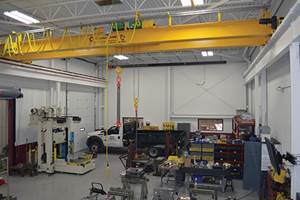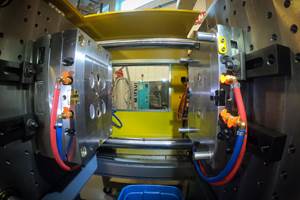The Bottom Line: Tax-Change Predictions
Along with a new president, the new year is bound to usher in changes to U.S. tax laws.
Changes to U.S. tax laws are almost certain, as President-elect Donald Trump takes the oath of office later this month and the Republican Party maintains control of both houses of Congress. However, it is difficult to predict how these changes will impact U.S. mold builders. Most tax changes will either be in the form of new legislation or new treasury regulations.
When it comes to legislative tax changes, many believe that tax reform is on the way. The last major overhaul of the tax code was in 1986 when Ronald Reagan signed the Tax Reform Act, but much has changed since that time. Manufacturing and the world economy are very different, so we can expect a different type of tax reform if it were to occur this year.
We can also expect significant regulatory changes in a Trump administration. Candidate Trump promised to roll back many of the regulations President Barak Obama promoted during his two terms. Topping the list, according to political commentators, are regulations interpreting the Dodd-Frank Wall Street Reform and Consumer Protection Act, and EPA rules such as the Clean Power Plan and the Clean Water Rule. If rescinded, these regulations could both directly and indirectly benefit mold builders. For example, removing or limiting the Dodd-Frank regulations may ease compliance burdens for small and community banks, allowing them to lend to mold builders in a more expedient fashion. However, these regulatory changes at the top of Trump’s list are not tax-related, so we may not see a rescission of burdensome tax regulations in the first 100 days. Instead, they may happen in the first or second year of the Trump administration.
Following is a look at some of the possibilities.
Tax Reform
With the Republican Party in control of the presidency and both houses of Congress, all of the tax plans have a chance of becoming law. That said, not all members of the Republican Party are on the same page with respect to reform. Going into 2017, tax provisions in three different competing and complementing plans will vie for spots in a potential tax reform bill. These include the U.S. Senate’s plans for corporate integration, the U.S. House of Representatives’ “A Better Way” and Trump’s proposal for tax reform.
The Senate’s corporate integration proposal is different from the others, because it is not actually a tax-reform plan. Rather, the ideas put forth by the Senate Finance Committee (SFC) would complement, not compete with, the other two tax-reform proposals. Corporate integration would level the playing field between C corporations and pass-through entities (S corporations, partnerships and limited liability companies), and fundamentally change the way corporations deduct the expenditures associated with financing their operations, such as interest expenditures for debt and dividends for equity.
The corporate integration proposal would allow C corporations to deduct dividends paid, impose withholding (35 percent) on dividends and interest, and eliminate the preferential dividend rate to offset the cost of the dividends deduction. The SFC believes that, by enacting these corporate integration provisions, more companies will be organized as C corporations, which would allow Congress to enact tax reform for businesses and individuals as separate endeavors. Also, by treating interest expense and dividends in the same way with respect to deductibility, the Treasury would not be favoring debt over equity. Currently, corporations may deduct interest expense, but may not deduct dividends paid to owners.
The House, however, has developed an outline for tax reform as part of its “A Better Way” proposal. Throughout 2016, the House released six different plans to tackle various issues within the country, including poverty, national security, the economy, the U.S. Constitution, healthcare and tax reform. The “Blueprint,” as it’s identified in the document released by Speaker Paul Ryan’s office, aims to simplify the code, increase jobs and fuel growth.
There are a number of similarities between the House proposal and Trump’s tax proposal (see chart). Both will impact moldmakers by:
- Flattening and reducing the individual income tax brackets and condensing seven tax brackets to three.
- Repealing the individual Alternative Minimum Tax (AMT).
- Repealing the corporate AMT.
- Allowing full and immediate expensing of machinery and equipment.
- Keeping the R&D tax credit, which is a provision of the code that many moldmakers use to reduce their federal income tax liabilities.
- Eliminating the 3.8-percent Obamacare tax on investment and passive income.
- Moving the U.S. to a territorial tax system, whereby multinational companies only pay U.S. tax on their domestic income.
Some differences do exist between the two plans, however, including the top corporate tax rate and the treatment of capital gains. The Blueprint proposes a flat corporate tax rate of 20 percent with a maximum tax rate of 25 percent on small business income from sole proprietorships or pass-through entities (S corporations, partnerships and LLCs). Trump’s plan lowers the top business tax rate from 35 percent to 15 percent. With respect to capital gains, the Blueprint allows individuals to deduct 50 percent of their net capital gains, providing a reduced tax rate on capital gains, while Trump’s proposal keeps the top capital gain rate at the existing capital gain rates, capped at 20 percent.
Finally, the Blueprint allows taxpayers to continue to use the last-in-first-out (LIFO) method of accounting, which assumes inventory purchased or produced last are used or sold first. In a time of rising costs, the LIFO method of accounting will defer the income tax obligations of the taxpayer. The Blueprint also permits corporations to deduct interest expense against interest income with no current deduction for net interest expense (a new concept of “interest netting”). Excess interest expense would be carried forward indefinitely and allowed against interest income in future tax years. Trump’s tax plan does not address the “interest netting” concept or the LIFO method of accounting.
Regulations
Numerous tax regulations that impact moldmakers also have been discussed in recent years. Among the most impactful are the finalized research expenditure and credit regulations, the finalized tangible property regulations, the proposed domestic production activities deduction regulations, and the proposed rules limiting discounts for lack of control or marketability on the transfer of businesses to younger generations.
Generally, the research expenditure and credit regulations were taxpayer-friendly, and we expect the Trump administration to leave these rules in place. Also, the proposed rules interpreting the law for the domestic production activities deductions are viewed as less burdensome, something the Trump campaign hit on as a worthy goal throughout the past year.
The proposed rules limiting discounts for lack of control and marketability do not yet carry the weight of law (they are still in a proposed form at the time of this writing), and some commentators in the estate-tax-planning industry have indicated that they are dead on arrival, given Trump’s propensity to abolish the estate tax.
Finally, the tangible property regulations are likely to remain unchanged unless Congress changes the way companies deduct their investments in buildings, machinery and equipment, by allowing for the immediate expensing of machinery and equipment, which is a very possible outcome of tax reform.
With all that being said, it may be a year or more until treasury regulations become the focus of the upcoming administration, so mold builders would be wise to follow current regulatory interpretations until the new administration proposes any potential changes formally. While many believe the election results did not provide a mandate to Congress and the future administration, one thing is for sure: Tax changes are coming. Hopefully, these changes will help mold builders as they compete in the world market.
Related Content
Think Safety: Eliminate Hazards Throughout the Shop
The tooling community is taking advantage of new products for safer mold shops and molding facilities.
Read MoreThe Trifecta of Competitive Toolmaking
Process, technology and people form the foundations of the business philosophy in place at Eifel Mold & Engineering.
Read MorePredictive Manufacturing Moves Mold Builder into Advanced Medical Component Manufacturing
From a hot rod hobby, medical molds and shop performance to technology extremes, key relationships and a growth strategy, it’s obvious details matter at Eden Tool.
Read MoreMaking Mentoring Work | MMT Chat Part 2
Three of the TK Mold and Engineering team in Romeo, Michigan join me for Part 2 of this MMT Chat on mentorship by sharing how the AMBA’s Meet a Mentor Program works, lessons learned (and applied) and the way your shop can join this effort.
Read MoreRead Next
The Bottom Line: A Method to the Tax Madness
Every shop must adopt a method of accounting for activities within its business, and cash and accrual methods are two commonly used ones.
Read MoreReasons to Use Fiber Lasers for Mold Cleaning
Fiber lasers offer a simplicity, speed, control and portability, minimizing mold cleaning risks.
Read MoreHow to Use Continuing Education to Remain Competitive in Moldmaking
Continued training helps moldmakers make tooling decisions and properly use the latest cutting tool to efficiently machine high-quality molds.
Read More


















